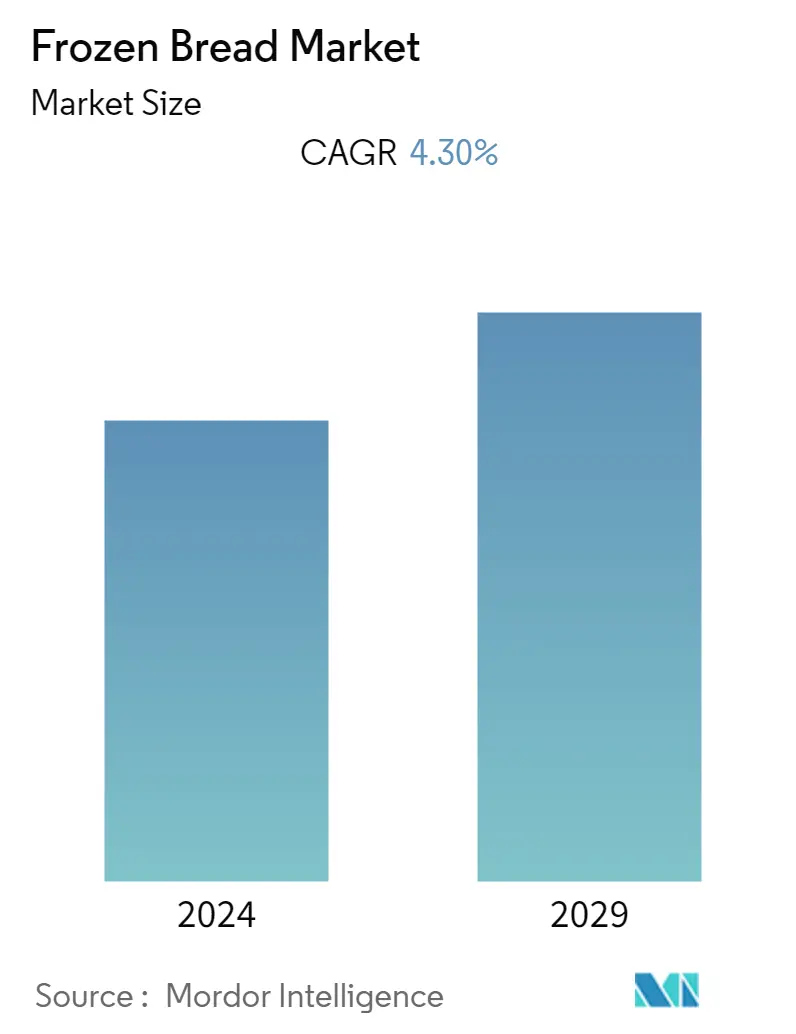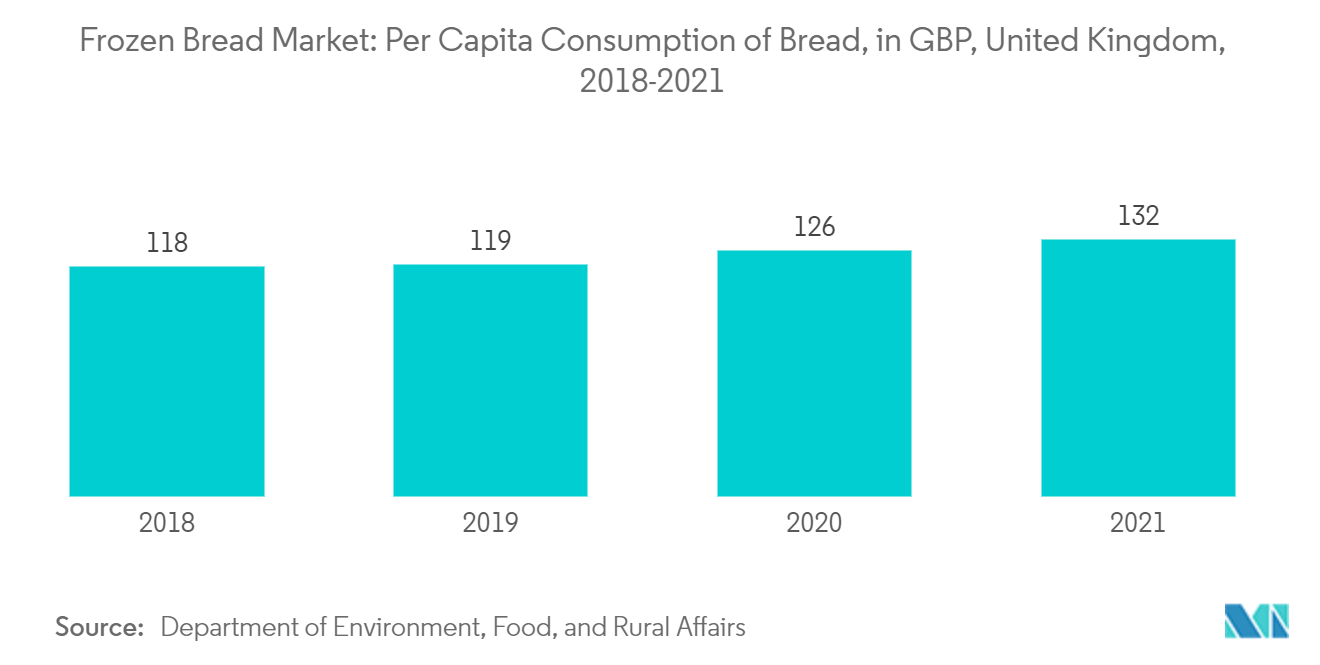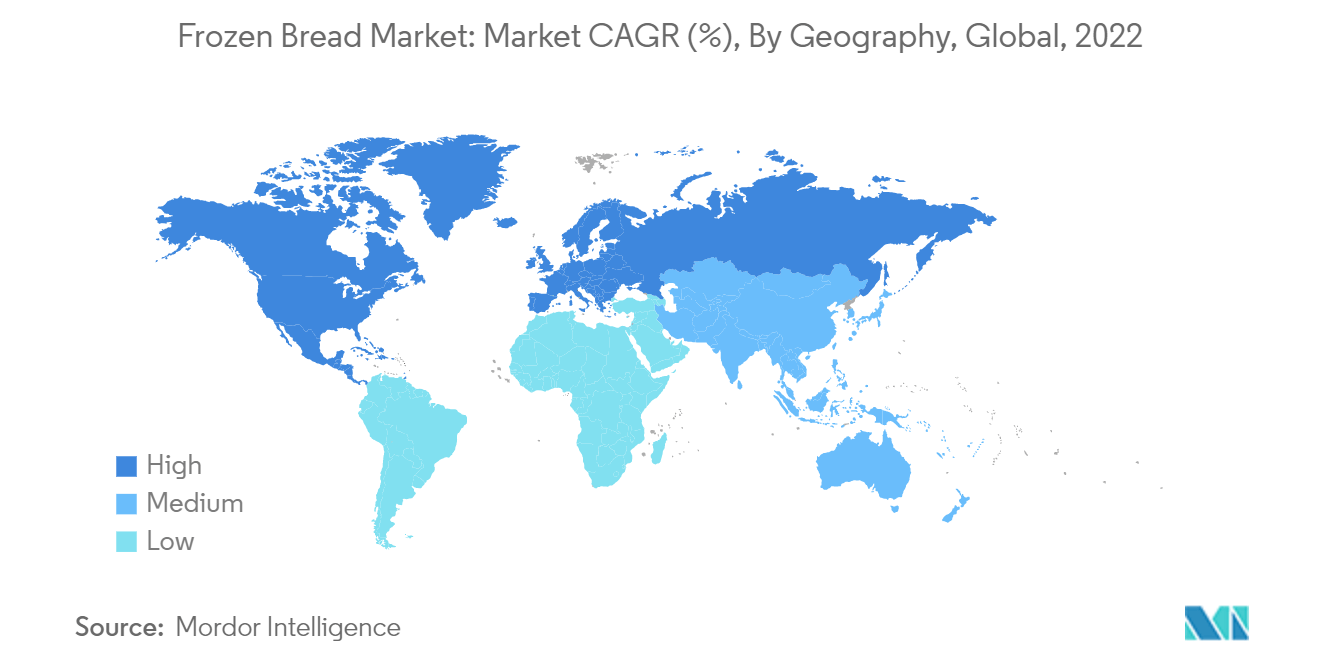Frozen Bread Market Size

| Study Period | 2019 - 2029 |
| Base Year For Estimation | 2023 |
| CAGR | 4.30 % |
| Fastest Growing Market | Asia Pacific |
| Largest Market | Europe |
| Market Concentration | Low |
Major Players.webp)
*Disclaimer: Major Players sorted in no particular order |
Frozen Bread Market Analysis
The frozen bread market is projected to register a CAGR of 4.3% during the forecast period.
- Key factors contributing to the growth of frozen bakeries include a rising preference for convenient food and the popularity of specialty frozen bakery products. Intra-industry competitiveness is high and affects the market. The cake and pastry segment is on the rise in the frozen bakery products market. With the growing demand for premium and customized cakes, the overall cake market witnesses increased demand. The demand for healthy and convenient food that can be consumed instantly is on the rise due to the fast-paced lifestyle and the need for quick meals or snacks among adults.
- Frozen bakery products are considered to provide these benefits, as most of them can be cooked quickly for consumption. These factors propel the market growth. According to the United States Department of Agriculture (USDA) April 2021, 72.0% of Americans purchased frozen food due to their busy life schedules. These facts are likely to bode well with the market growth. The increasing health and safety concerns amid rising COVID-19 cases obligated people to take fewer trips to stores to buy household items, including food and snacks.
- On-the-go snacking is becoming extremely popular, especially among the working class, teenagers, people living in hostels, and bachelors, due to their hectic lifestyles. Moreover, the on-the-go snacking concept is closely associated with the easy consumption and handling of products. Thus, the demand for frozen bakery products is increasing due to the linked convenience of consumption, aided by innovative flavors and ingredients and the taste preference of consumers.
- The frozen bakery industry is driven by the increasing demand for specialty goods, constituting functional ingredients. Oats, legumes, nuts, probiotics, cereals, and fortified margarine are some of the functional ingredients used to enhance the nutritional value of frozen bakery products. Almost every bakery product can be customized per the customer's needs and requirements. Thus, the flexibility and ease of customization make the specialty frozen baked products market more lucrative.
Frozen Bread Market Trends
Rising Demand for Ready to Bake Bakery Products
- The demand for healthy and convenient food options has led to a shift in the bakery industry towards bake-off technologies (BOTs). Industrial bakers in Europe are focusing on producing frozen bakery products, such as unfermented frozen dough (UFD), partially-baked frozen bread (PBF), and partially-baked unfrozen bread (PBUF), as well as frozen semi-baked goods and ready-to-bake goods. These products require less time for baking and cooking, making them a convenient option for busy consumers.
- The frozen bakery market has experienced significant growth due to the hectic lifestyles of consumers. In the United States, for example, 72.0% of Americans purchased frozen food in April 2021 due to their busy schedules. Pre-proofed frozen dough is a convenient alternative to fresh-baked bread, and bakery products like bread, rolls, and bagels are typically served as ready-to-thaw products, while croissants and pastries are available in ready-to-bake form.
- According to Agriculture and Agri-Food Canada, in 2021, 4.1 thousand metric tons of frozen baked goods were projected to be sold in retail. Bake-off bakery production has become a key focus for European industrial bakers, as scratch baking is labor-intensive and time-consuming. With the rising demand for healthy and convenient food options, the market for frozen bakery products is expected to continue growing globally.

Europe Holds A Significant Market Share
- The European frozen bakery industry is at the forefront of the frozen bakery market, with the Western European market being matured and saturated. On the other hand, the emerging markets of Eastern Europe are driving bread sales due to the high demand for convenient food products. The European frozen bakery market has a well-established supply chain, product array, distribution channels, and consumer preferences.
- The indulgence category, which includes cakes, pastries, and cookies, is witnessing a rise in innovation and new product development. Co-operatives and industrial baking companies dominate the European frozen bakery market due to their ability to produce high-quality and consistent part-baked products.
- The increase in consumer preference for convenience food products has indirectly encouraged the demand for frozen bakery products as they require less time and effort. The rise in per capita income and the trend of snacking between meals are key factors driving the demand for frozen bakery products.
- The development of retail channels, such as supermarkets, hypermarkets, convenience stores, and specialty stores, has also contributed to the growth of the market. Furthermore, frozen bakery products do not involve scratch baking and thus require less labor, making them a preferred option for various bakers who now prefer to keep frozen baked and parbaked items in their in-store bakeries.
- Finally, the high growth of the frozen food industry, particularly in developing countries, due to the fast-growing urban households, is projected to drive the demand for frozen bakery products.

Frozen Bread Industry Overview
The global frozen bread market is highly competitive, with a large number of players operating in the industry. To drive growth, the key players are utilizing various growth strategies such as mergers and acquisitions, expanding their businesses, developing new products, and forming partnerships.
Some of the major players in the frozen bread market include Aryzta AG, Europastry SA, General Mills Inc., Grupo Bimbo SAB de CV, and Campbell Soup Company. These companies are focusing on introducing new products that offer healthier ingredients and organic claims as their primary marketing strategy.
Frozen Bread Market Leaders
-
Campbell Soup Company
-
Grupo Bimbo SAB de CV
-
General Mills Inc.
-
Aryzta AG
-
Europastry SA
*Disclaimer: Major Players sorted in no particular order

Frozen Bread Market News
- December 2022: Europastry SA announced the acquisition of global bakery manufacturer and distributor Dawn Foods, which included its frozen bakery manufacturing business in Africa, Asia, the Middle East, Europe, and the Pacific. The deal included Dawn's manufacturing facility for frozen baked goods in Steenbergen, the Netherlands, research & development capabilities in Evesham, the United Kingdom, and all related client ties in the area that bought frozen goods manufactured by Dawn.
- July 2021: Dawn Food Products Inc. acquired Icopa, one of the largest distributors of bakery products. The strategy behind the acquisition is to strengthen distribution channels and manage the company's supply chain. The company is also planning to enlarge its business using this strategy as it can offer its products to numerous consumers with quick turnaround times.
- May 2021: General Mills Inc. announced the launch of its six latest Pillsbury products in its frozen bakery product line. The Pillsbury Monkey Bread contains pre-cut dough with each kit, with a sweet cinnamon sauce pouch containing 10 g of sugar, 200 calories, and 3 g of protein.
- March 2021: Almarai agreed to buy frozen bakery item manufacturer and producer Bakemart, which operates in the United Arab Emirates and Bahrain.
Frozen Bread Market Report - Table of Contents
1. INTRODUCTION
- 1.1 Study Assumptions and Market Definitions
- 1.2 Scope of the Study
2. RESEARCH METHODOLOGY
3. EXECUTIVE SUMMARY
4. MARKET DYNAMICS
- 4.1 Market Drivers
- 4.2 Market Restraints
-
4.3 Porter's Five Forces Analysis
- 4.3.1 Threat of New Entrants
- 4.3.2 Bargaining Power of Buyers/Consumers
- 4.3.3 Bargaining Power of Suppliers
- 4.3.4 Threat of Substitute Products
- 4.3.5 Intensity of Competitive Rivalry
5. MARKET SEGMENTATION
-
5.1 Product Type
- 5.1.1 Conventional Bread
- 5.1.2 Gluten-free Bread
-
5.2 Distribution Channel
- 5.2.1 Retail Channels
- 5.2.2 Food Service
-
5.3 Geography
- 5.3.1 North America
- 5.3.1.1 United States
- 5.3.1.2 Canada
- 5.3.1.3 Mexico
- 5.3.1.4 Rest of North America
- 5.3.2 Europe
- 5.3.2.1 Spain
- 5.3.2.2 United Kingdom
- 5.3.2.3 Germany
- 5.3.2.4 France
- 5.3.2.5 Italy
- 5.3.2.6 Russia
- 5.3.2.7 Rest of Europe
- 5.3.3 Asia Pacific
- 5.3.3.1 China
- 5.3.3.2 Japan
- 5.3.3.3 India
- 5.3.3.4 Australia
- 5.3.3.5 Rest of Asia-Pacific
- 5.3.4 South America
- 5.3.4.1 Brazil
- 5.3.4.2 Argentina
- 5.3.4.3 Rest of South America
- 5.3.5 Middle East and Africa
- 5.3.5.1 South Africa
- 5.3.5.2 United Arab Emirates
- 5.3.5.3 Rest of Middle East and Africa
6. COMPETITIVE LANDSCAPE
- 6.1 Most Adopted Strategies
- 6.2 Market Share Analysis
-
6.3 Company Profiles
- 6.3.1 General Mills Inc.
- 6.3.2 Sunbulah Group
- 6.3.3 Aryzta AG
- 6.3.4 Bridgford Foods Corporation
- 6.3.5 Campbell Soup Company
- 6.3.6 Grupo Bimbo SAB de CV
- 6.3.7 Flower Foods Inc
- 6.3.8 Associated British Foods PLC
- 6.3.9 Atyab Food Industries
- 6.3.10 Emad Bakeries
- 6.3.11 Europastry SA
- 6.3.12 Dawn Food Products Inc.
- 6.3.13 Almarai Company
- *List Not Exhaustive
7. MARKET OPPORTUNITIES AND FUTURE TRENDS
** Subject To AvailablityFrozen Bread Industry Segmentation
Bread is often frozen to preserve freshness or extend shelf life.
The scope of the frozen bread market includes segmentation into product type, distribution channel, and geography. By product type, the market is segmented into conventional bread and gluten-free bread. The market is divided based on distribution channel, which includes retail channels and food service. The study also involves the global level analysis of the main regions such as North America, Europe, Asia-Pacific, South America, the Middle East, and Africa.
For each segment, market sizing and forecast have been done based on value (USD million).
| Product Type | Conventional Bread | |
| Gluten-free Bread | ||
| Distribution Channel | Retail Channels | |
| Food Service | ||
| Geography | North America | United States |
| Canada | ||
| Mexico | ||
| Rest of North America | ||
| Geography | Europe | Spain |
| United Kingdom | ||
| Germany | ||
| France | ||
| Italy | ||
| Russia | ||
| Rest of Europe | ||
| Geography | Asia Pacific | China |
| Japan | ||
| India | ||
| Australia | ||
| Rest of Asia-Pacific | ||
| Geography | South America | Brazil |
| Argentina | ||
| Rest of South America | ||
| Geography | Middle East and Africa | South Africa |
| United Arab Emirates | ||
| Rest of Middle East and Africa |
Frozen Bread Market Research FAQs
What is the current Frozen Bread Market size?
The Frozen Bread Market is projected to register a CAGR of 4.30% during the forecast period (2024-2029)
Who are the key players in Frozen Bread Market?
Campbell Soup Company, Grupo Bimbo SAB de CV, General Mills Inc., Aryzta AG and Europastry SA are the major companies operating in the Frozen Bread Market.
Which is the fastest growing region in Frozen Bread Market?
Asia Pacific is estimated to grow at the highest CAGR over the forecast period (2024-2029).
Which region has the biggest share in Frozen Bread Market?
In 2024, the Europe accounts for the largest market share in Frozen Bread Market.
What years does this Frozen Bread Market cover?
The report covers the Frozen Bread Market historical market size for years: 2019, 2020, 2021, 2022 and 2023. The report also forecasts the Frozen Bread Market size for years: 2024, 2025, 2026, 2027, 2028 and 2029.
Frozen Bread Industry Report
Statistics for the 2024 Frozen Bread market share, size and revenue growth rate, created by Mordor Intelligence™ Industry Reports. Frozen Bread analysis includes a market forecast outlook to 2029 and historical overview. Get a sample of this industry analysis as a free report PDF download.



